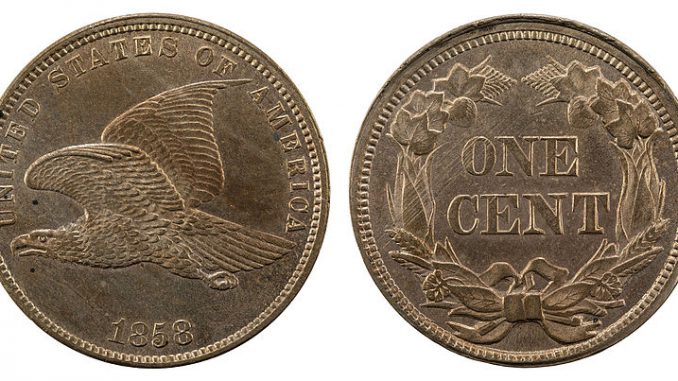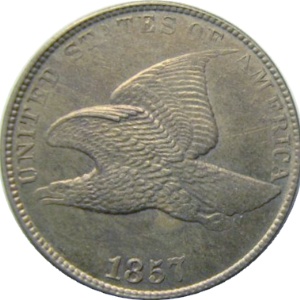
Flying Eagle Cents – The High Point in US Coinage?
By Arthur Haule
1856 marked an auspicious year in the history of the US Mint. From the very beginning, one cent pieces had been a staple of United States coins. Everyone knew their look and their feel. Everyone was comfortable with the coin, until 1856.
Since the beginning of US coinage, the face of the one cent piece had featured a depiction of the goddess Liberty. Admittedly, there had been several different depictions of Liberty, with each providing its coin with an interesting name. Flowing Hair Cents were produced by the US Mint from 1793 through 1796, when they were replaced by Draped Bust Cents. The Classic Head Cent design was the design produced from 1808 through 1814 when it was replaced by the Coronet Head Cent. Finally, the Braided Hair Cent took center stage in 1839. It was also referred to as the “Silly Head” or the “Booby Head” Cent. The Braided Hair Cent was produced through 1857.
People began to object to carrying around these coins. Some people said the coins were too large, with a diameter of 27.5 millimeters (merchants complained that the coins “clogged up” their tills). There were complaints that the coins were too heavy, weighing in at a hefty 10.89 grams. The public seemed to be ready for a change in its pennies.

In 1856 the US Mint began producing a smaller, lighter one cent coin. The Flying Eagle Cent was the first of what collectors now refer to as “Small Cents” (weighing 4.7 grams with a diameter of 19 millimeters) contrasted with the one cent coins heretofore produced being dubbed “Large Cents.”
The public did not like the coin. The Flying Eagle Cent did not consist of pure copper, as had all one previous one cent coins. It was 88% copper and 12% nickel. The lighter color caused the public to derogatorily refer to the new cent as the “white cent.” People were not pleased with the design either. Although design on the obverse (or face) of James Barton Longacre’s coin depicts an Eagle in Flight, people sometimes referred to the coin as the “Buzzard Cent.”
Officials at the US Mint were embarrassed. They quickly made plans to redesign the coin. Longacre was commissioned to produce the new design. The Eagle was removed, and Liberty returned to the front of the one cent coin, this time wearing a Native American headdress. The Indian Head Cent remains one of the most popular coins ever produced by the US Mint, while the Flying Eagle Cent took its place among the coins with the briefest mintage in US history…just two years (1857-1858).

Incidentally, if you happen to find a Flying Eagle Cent bearing the date 1856, you would be well-advised to take the coin to an expert to have it evaluated. The 1856 coins were only produced as examples to be presented to Congress and other officials to encourage them to support the coin’s acceptance. Once the vote was taken, legislators were supposed to return the coins to the US Treasury. The coins were supposed to be destroyed, and minting of the Flying Eagle Cent to begin in 1857.
Somehow, not all of the coins made their way back to the Mint. Evidently some of them were kept as souvenirs by various people. The coins’ rarity caused their collector’s value to soar. Now, even the most mediocre specimens of the 1856 Flying Eagle Cent sell for in excess of $5,000, with the nicest of these coins expected to bring well in excess of $100,000. (The Professional Coin Grading Service lists the value of the highest grade Flying Eagles they have certified as $150,000.) Needless to say, counterfeiters have taken note of these numbers and have taken steps to attempt to defraud people by producing and selling fakes.
So a set of Flying Eagle Cents consists of three coins . . . the 1857, and two varieties (Large Letters and Small Letters) of the 1858. You can purchase attractive specimens of all three coins for a total of less than $200.
Arthur Haule began collecting coins in 1962. He is a member of the American Numismatic Association, and runs several coin-related web pages which can be accessed from the main Squidoo coin page at http://www.squidoo.com/icollectcoins . When not working on these pages or his Violin Student Central website, he can usually be found reading about and playing around with coins, classical music, American History or Biblical topics from his home in the Dallas/Fort Worth Metroplex where he lives with his school administrator wife, Katherine, his basketball-loving daughter, Adriana, the canine member of the family, Gibson, and Chester the hamster.
Article Source: Flying Eagle Cents – The High Point in US Coinage?








